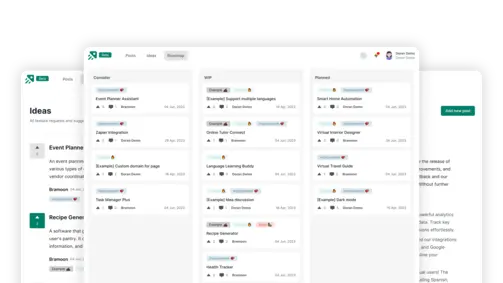Boost Customer Satisfaction with Feedback Management
Create changelog and product roadmap for your product
Explore nowTable of contents 6 min
Improving customer satisfaction through effective customer feedback management plays a vital role in the success of a business. Actively seeking and responding to feedback, analyzing insights, and implementing changes to enhance the customer experience will help you increase loyalty and drive business success. Here, let’s take a closer look at how to improve customer satisfaction.
Definition of Customer Feedback Management
Customer feedback management is the process of systematically collecting, analyzing, and utilizing customer feedback to improve business operations, products, and services. It involves gathering feedback through surveys, reviews, and other channels, organizing and analyzing it to identify insights and trends, and taking action to address customer concerns.
By actively listening to customers and prioritizing their needs, organizations can enhance customer satisfaction and loyalty. Customer feedback management fosters a customer-centric culture, enabling businesses to proactively respond to issues, communicate transparently, and innovate to meet evolving customer expectations. It is a valuable tool for optimizing offerings and delivering exceptional customer experiences.

The Importance of Customer Feedback Management
Customer feedback management is crucial for businesses to thrive in today’s competitive market. Here are key reasons why customer feedback management is essential:
Customer Insights
Managing customer feedback provides deep insights into customer preferences, pain points, and expectations. This understanding helps in developing customer-centric strategies and delivering personalized experiences.
Continuous Improvement
Customer feedback identifies areas for improvement, enabling businesses to refine their offerings and enhance customer satisfaction. Actively seeking feedback allows organizations to stay relevant and meet changing customer needs.
Customer Satisfaction and Loyalty
By valuing and acting upon customer feedback, organizations demonstrate a commitment to exceptional experiences, fostering customer satisfaction and loyalty. Satisfied customers become brand advocates, contributing to business growth.
Competitive Advantage
Proactive customer feedback management gives organizations a competitive edge. By leveraging customer insights, businesses can differentiate themselves, tailor offerings, and stay ahead of competitors.
Brand Reputation Management
Effective management of customer feedback enhances brand reputation. Positive feedback builds trust, while addressing negative feedback transparently demonstrates dedication to customer satisfaction.

Innovation and Product Development
Customer feedback fuels innovation by identifying new opportunities and unmet needs. Integrating feedback into the product development process ensures offerings align with customer expectations.
Customer Engagement and Retention
Engaging customers in the feedback process strengthens their connection to the business. Actively seeking feedback fosters a sense of ownership, leading to higher customer retention rates.
In conclusion, customer feedback management provides insights, drives improvement, enhances satisfaction, and builds loyalty. By embracing customer feedback, organizations can continuously improve, adapt to customer needs, and achieve long-term success.
How to Improve Customer Satisfaction with Feedback Management
Customer satisfaction is a critical factor in the success of any business. By effectively managing customer feedback, organizations can enhance their offerings, address concerns, and ultimately improve customer satisfaction. Here are key strategies to improve customer satisfaction through feedback management:
Actively Seek Feedback
To improve customer satisfaction, actively solicit feedback from your customers. Offer multiple channels for feedback, such as online surveys, feedback forms, or social media platforms. Make it convenient and easy for customers to share their opinions. By actively seeking feedback, you demonstrate that you value their input and are committed to improving their experience.
Promptly Respond to Feedback
Respond promptly to customer feedback, regardless of whether it is positive or negative. Acknowledge and thank customers for their feedback. In the case of negative feedback, address the concerns with empathy and a willingness to resolve the issue. Prompt responses show customers that their opinions are valued and that their concerns are taken seriously.
Categorize and Analyze Feedback
Organize and categorize customer feedback to identify common themes and trends. This analysis helps to prioritize issues and areas for improvement. Look for patterns in customer feedback, such as recurring problems or opportunities for enhancement. By understanding the underlying issues, you can take targeted actions to address them and improve customer satisfaction.
Implement Customer Feedback into Decision-Making
Utilize customer feedback to drive decision-making processes within your organization. Base product enhancements, process improvements, and service modifications on the insights gained from customer feedback. When customers see their feedback being implemented, it strengthens their trust in your brand and enhances their satisfaction.

Train and Empower Staff
Your frontline staff play a vital role in managing customer feedback and satisfaction. Train and empower your employees to handle customer feedback effectively. Provide them with the necessary tools and resources to address customer concerns and resolve issues. Encourage a customer-centric culture where all staff members understand the importance of feedback and are committed to delivering exceptional customer experiences.
Regularly Communicate with Customers
Maintain regular communication with your customers to keep them informed about changes or improvements based on their feedback. Share updates on how their feedback has influenced your business and show appreciation for their input. Open lines of communication build trust and foster a sense of partnership between your organization and your customers.
Continuously Improve and Innovate
Customer feedback should be seen as an opportunity for continuous improvement and innovation. Actively seek suggestions and ideas from customers on how you can enhance your products, services, or processes. Encourage customer co-creation by involving them in the ideation and development phases. By constantly evolving and innovating, you show your commitment to meeting customer needs and exceeding their expectations.
Measure and Monitor Customer Satisfaction
Implement metrics and key performance indicators (KPIs) to measure and monitor customer satisfaction. Regularly track customer satisfaction scores, Net Promoter Score (NPS), or other relevant metrics to gauge your progress. Use this data to identify areas of improvement and set benchmarks for customer satisfaction goals.
Foster a Feedback-Friendly Environment
Create a feedback-friendly environment where customers feel comfortable sharing their opinions. Encourage feedback through incentives, loyalty programs, or gamification. Celebrate success stories resulting from customer feedback, highlighting the positive impact it has on your business.
In conclusion, improving customer satisfaction through customer feedback management requires a systematic approach. Actively seeking feedback, promptly responding, analyzing insights, implementing changes, empowering staff, and fostering innovation are all essential elements. By prioritizing customer satisfaction and continuously enhancing your offerings based on customer feedback, you can build strong customer relationships, increase loyalty, and drive long-term business success.
What to not miss out on our blog
Gain insightful knowledge and invaluable experiences from dedicated experts.

CRM System Explained: Benefits, Types, and How It Works
Discover everything about CRM system. Learn the benefits and how a CRM system works to improve customer relationships and streamline business operations.

Are you ready? Start your free trial today.
Enhance communication, keep track of the progress, understand customers' insight and more by taking your first trial on Doran.
Sign up for free

